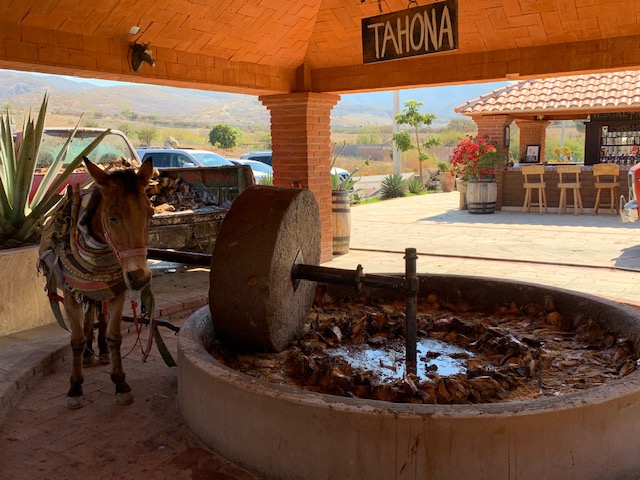
El corazon de mezcal landia – Oaxaca, where the drink is poured in abundance – even at my Spanish school for our 11am break on Fridays – a regular TGIF. A trip to the agave fields and the palenque de mezcaleria was high on my “let’s do” list.
The maguey or more commonly referred to as agave or century plant is used to make several popular alcoholic beverages including pulque, bancanora, mezcal and tequila.

The agave espadin supplies bout 90% of all mezcal. The other types of mezcal are made from wild agaves and can result in amazing flavors, however, are usually more expensive.
A mature espadin agave is harvested in approximately eight years. First the woody leaves are hacked away leaving the pina.

The pinas, which can weigh up to 200 pounds, are slow roasted in a large conical pit in the ground over smoldering stones. Fresh roasted agave tastes a bit like sweet and smokey, caramelized fibers of sugar cane. Next the mezcalero hacks the roasted hearts into palm-size chunks with their machete.

The chunks of roasted agave hearts are pulverized by a tahona, a big stone wheel pulled in a circle by an ox, bull, or burro, preparing the pulp for fermentation.

The mashed agave pulp is shoveled into open-air wooden barrels to ferment for four to 10 days. Fermenting occurs in two stages: a dry fermentation of the pulp and its juices, followed by a wet fermentation with water added.

Finally, the fermented pulp is distilled usually twice and sometimes three times. And then you have – oh yeah – mezcal.

There are three certified grades of mezcal:
• Mezcal ancestral, the most authentic, which must be distilled in a clay pot
• Mezcal artisanal which includes agave fibers
• Mezcal industrial which involves machines in the processing
You can still buy the non-certified mezcal in unlabeled bottles at many of the local mercados and mezcalerias, a bit like moonshine.
I have found the best way to learn about this artisanal spirit is to taste as much as you can by sipping it from a small cup. Flavors and quality vary greatly. I have especially enjoyed the Madre-cuishe, made from a wild agave, as it seems smoother and less fiery. Remember, the alcohol content of mezcal is in the range of 40-60%.
And now, time for some mezcal. Una mas por favor.
Salude.
